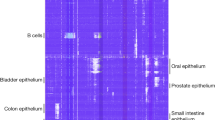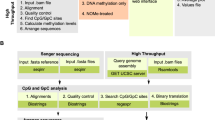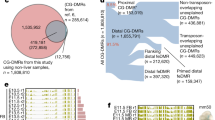Abstract
DNA methylation is the most stable type of epigenetic modification modulating the transcriptional plasticity of mammalian genomes. Using bisulfite DNA sequencing, we report high-resolution methylation profiles of human chromosomes 6, 20 and 22, providing a resource of about 1.9 million CpG methylation values derived from 12 different tissues. Analysis of six annotation categories showed that evolutionarily conserved regions are the predominant sites for differential DNA methylation and that a core region surrounding the transcriptional start site is an informative surrogate for promoter methylation. We find that 17% of the 873 analyzed genes are differentially methylated in their 5′ UTRs and that about one-third of the differentially methylated 5′ UTRs are inversely correlated with transcription. Despite the fact that our study controlled for factors reported to affect DNA methylation such as sex and age, we did not find any significant attributable effects. Our data suggest DNA methylation to be ontogenetically more stable than previously thought.
This is a preview of subscription content, access via your institution
Access options
Subscribe to this journal
Receive 12 print issues and online access
$209.00 per year
only $17.42 per issue
Buy this article
- Purchase on Springer Link
- Instant access to full article PDF
Prices may be subject to local taxes which are calculated during checkout







Similar content being viewed by others
References
International Human Genome Sequencing Consortium. Finishing the euchromatic sequence of the human genome. Nature 431, 931–945 (2004).
Lander, E.S. et al. Initial sequencing and analysis of the human genome. Nature 409, 860–921 (2001).
Jaenisch, R. & Bird, A. Epigenetic regulation of gene expression: how the genome integrates intrinsic and environmental signals. Nat. Genet. 33, 245–254 (2003).
Murrell, A., Rakyan, V.K. & Beck, S. From genome to epigenome. Hum. Mol. Genet. 14, R3–R10 (2005).
Jones, P.A. & Martienssen, R. A blueprint for a Human Epigenome Project: the AACR Human Epigenome Workshop. Cancer Res. 65, 11241–11246 (2005).
Rakyan, V.K. et al. DNA methylation profiling of the human major histocompatibility complex: a pilot study for the human epigenome project. PLoS Biol. 2, 2170–2182 (2004).
Weber, M. et al. Chromosome-wide and promoter-specific analyses identify sites of differential DNA methylation in normal and transformed human cells. Nat. Genet. 37, 853–862 (2005).
Schumacher, A. et al. Microarray-based DNA methylation profiling: technology and applications. Nucleic Acids Res. 34, 528–542 (2006).
Khulan, B. et al. Comparative isoschizomer profiling of cytosine methylation: The HELP assay. Genome Res. 16, 1046–1055 (2006).
Frommer, M. et al. A genomic sequencing protocol that yields a positive display of 5-methylcytosine residues in individual DNA strands. Proc. Natl. Acad. Sci. USA 89, 1827–1831 (1992).
Strichman-Almashanu, L.Z. et al. A genome-wide screen for normally methylated human CpG islands that can identify novel imprinted genes. Genome Res. 12, 543–554 (2002).
Smiraglia, D.J. et al. Excessive CpG island hypermethylation in cancer cell lines versus primary human malignancies. Hum. Mol. Genet. 10, 1413–1419 (2001).
Grunau, C., Hindermann, W. & Rosenthal, A. Large-scale methylation analysis of human genomic DNA reveals tissue-specific differences between the methylation profiles of genes and pseudogenes. Hum. Mol. Genet. 9, 2651–2663 (2000).
Duncan, B.K. & Miller, J.H. Mutagenic deamination of cytosine residues in DNA. Nature 287, 560–561 (1980).
Hayward, B.E. et al. The human GNAS1 gene is imprinted and encodes distinct paternally and biallelically expressed G proteins. Proc. Natl. Acad. Sci. USA 95, 10038–10043 (1998).
Kalscheuer, V.M., Mariman, E.C., Schepens, M.T., Rehder, H. & Ropers, H.H. The insulin-like growth factor type-2 receptor gene is imprinted in the mouse but not in humans. Nat. Genet. 5, 74–78 (1993).
Verhaagh, S., Schweifer, N., Barlow, D.P. & Zwart, R. Cloning of the mouse and human solute carrier 22a3 (Slc22a3/SLC22A3) identifies a conserved cluster of three organic cation transporters on mouse chromosome 17 and human 6q26-q27. Genomics 55, 209–218 (1999).
Xu, G.L. et al. Chromosome instability and immunodeficiency syndrome caused by mutations in a DNA methyltransferase gene. Nature 402, 187–191 (1999).
Frigola, J. et al. Epigenetic remodeling in colorectal cancer results in coordinate gene suppression across an entire chromosome band. Nat. Genet. 38, 540–549 (2006).
Zeng, W. et al. Transcript profile of CD4+ and CD8+ T cells from the bone marrow of acquired aplastic anemia patients. Exp. Hematol. 32, 806–814 (2004).
Ashurst, J.L. et al. The Vertebrate Genome Annotation (Vega) database. Nucleic Acids Res. 33, D459–D465 (2005).
Down, T.A. & Hubbard, T.J.P. Computational detection and location of transcription start sites in mammalian genomic DNA. Genome Res. 12, 458–461 (2002).
Fuks, F. DNA methylation and histone modifications: teaming up to silence genes. Curr. Opin. Genet. Dev. 15, 490–495 (2005).
Cawley, S. et al. Unbiased mapping of transcription factor binding sites along human chromosomes 21 and 22 points to widespread regulation of noncoding RNAs. Cell 116, 499–509 (2004).
Mancini, D.N., Singh, S.M., Archer, T.K. & Rodenhiser, D.I. Site-specific DNA methylation in the neurofibromatosis (NF1) promoter interferes with binding of CREB and SP1 transcription factors. Oncogene 18, 4108–4119 (1999).
Clark, S.J., Harrison, J. & Molloy, P.L. Sp1 binding is inhibited by (m)Cp(m)CpG methylation. Gene 195, 67–71 (1997).
Holler, M., Westin, G., Jiricny, J. & Schaffner, W. Sp1 transcription factor binds DNA and activates transcription even when the binding site is CpG methylated. Genes Dev. 2, 1127–1135 (1988).
Harrington, M.A., Jones, P.A., Imagawa, M. & Karin, M. Cytosine methylation does not affect binding of transcription factor Sp1. Proc. Natl. Acad. Sci. USA 85, 2066–2070 (1988).
Fraga, M.F. et al. Epigenetic differences arise during the lifetime of monozygotic twins. Proc. Natl. Acad. Sci. USA 102, 10604–10609 (2005).
Shiota, K. DNA methylation profiles of CpG islands for cellular differentiation and development in mammals. Cytogenet. Genome Res. 105, 325–334 (2004).
Costello, J.F., Smiraglia, D.J. & Plass, C. Restriction landmark genome scanning. Methods 27, 144–149 (2002).
Shiota, K. et al. Epigenetic marks by DNA methylation specific to stem, germ and somatic cells in mice. Genes Cells 7, 961–969 (2002).
Ansel, K.M., Djuretic, I., Tanasa, B. & Rao, A. Regulation of Th2 differentiation and Il4 locus accessibility. Annu. Rev. Immunol. 24, 607–656 (2006).
Jones, P.A. & Baylin, S.B. The fundamental role of epigenetic events in cancer. Nat. Rev. Genet. 3, 415–428 (2002).
Song, F. et al. Association of tissue-specific differentially methylated regions (TDMs) with differential gene expression. Proc. Natl. Acad. Sci. USA 102, 3336–3341 (2005).
Futscher, B.W. et al. Role for DNA methylation in the control of cell type specific maspin expression. Nat. Genet. 31, 175–179 (2002).
Bernstein, B.E. et al. Genomic maps and comparative analysis of histone modifications in human and mouse. Cell 120, 169–181 (2005).
ENCODE Project Consortium. The ENCODE (ENCyclopedia Of DNA Elements) Project. Science 306, 636–640 (2004).
International HapMap Consortium. A haplotype map of the human genome. Nature 437, 1299–1320 (2005).
Yoo, C.B. & Jones, P.A. Epigenetic therapy of cancer: past, present and future. Nat. Rev. Drug Discov. 5, 37–50 (2006).
Widschwendter, M. et al. Association of breast cancer DNA methylation profiles with hormone receptor status and response to tamoxifen. Cancer Res. 64, 3807–3813 (2004).
Bjornsson, H.T., Fallin, M.D. & Feinberg, A.P. An integrated epigenetic and genetic approach to common human disease. Trends Genet. 20, 350–358 (2004).
Curwen, V. et al. The Ensembl automatic gene annotation system. Genome Res. 14, 942–950 (2004).
Gardiner-Garden, M. & Frommer, M. CpG islands in vertebrate genomes. J. Mol. Biol. 196, 261–282 (1987).
Takai, D. & Jones, P.A. Comprehensive analysis of CpG islands in human chromosomes 21 and 22. Proc. Natl. Acad. Sci. USA 99, 3740–3745 (2002).
Berlin, K., Ballhause, M. & Cardon, K. Improved bisulfite conversion of DNA. Patent PCT/WO/2005/038051 (2005).
Lewin, J., Schmitt, A.O., Adorjan, P., Hildmann, T. & Piepenbrock, C. Quantitative DNA methylation analysis based on four-dye trace data from direct sequencing of PCR amplificates. Bioinformatics 20, 3005–3012 (2004).
Acknowledgements
We thank E. Calautti for his advice on culturing of keratinocytes, A. Meyerhans for critical reading of the manuscript, J. Maass for her help obtaining tissue samples and K. Fischer for his support providing genomic annotations. F.E. thanks Y.-S. Kim for many discussions. V.K.R. was supported by a C.J. Martin Fellowship from the National Health and Medical Research Council of Australia. J.A., J.B., T.C., R.D., T.A.D., R.H., K.H., D.K.J., J.L., D.N., R.P., T.W., J.R. and S.B. were supported by the Wellcome Trust.
Author information
Authors and Affiliations
Corresponding authors
Ethics declarations
Competing interests
S.B. is a member of the scientific advisory board of Epigenomics AG. K.B. and A.O. are founders of Epigenomics AG, A.O. is a consultant of this company, and K.B., M.B., R.C., F.E., C.H., C.K., J.K., J.L., T.O. and C.T. are employees of Epigenomics AG.
Supplementary information
Supplementary Fig. 1
Global methylation profiles of chromosomes 6, 20 and 22. (PDF 1082 kb)
Supplementary Fig. 2
Correlation between DNA methylation and CpG density. (PDF 953 kb)
Supplementary Fig. 3
Distinction of imprinting versus mosaicism at heterogeneously methylated loci. (PDF 890 kb)
Supplementary Fig. 4
Methylation of CGI- and non-CGI-containing 5′ UTRs. (PDF 1089 kb)
Supplementary Fig. 5
Cluster analysis of chromosome 22 amplicons. (PDF 987 kb)
Supplementary Fig. 6
Differentially methylated CGIs located within the 5′ UTR. (PDF 427 kb)
Supplementary Table 1
Sample details. (PDF 380 kb)
Supplementary Table 2
Examples of genes found to be differentially methylated. (PDF 552 kb)
Rights and permissions
About this article
Cite this article
Eckhardt, F., Lewin, J., Cortese, R. et al. DNA methylation profiling of human chromosomes 6, 20 and 22. Nat Genet 38, 1378–1385 (2006). https://doi.org/10.1038/ng1909
Received:
Accepted:
Published:
Issue Date:
DOI: https://doi.org/10.1038/ng1909
This article is cited by
-
Gbdmr: identifying differentially methylated CpG regions in the human genome via generalized beta regressions
BMC Bioinformatics (2024)
-
Differential methylation analysis in neuropathologically confirmed dementia with Lewy bodies
Communications Biology (2024)
-
Cross-tissue patterns of DNA hypomethylation reveal genetically distinct histories of cell development
BMC Genomics (2023)
-
Novel insights into systemic sclerosis using a sensitive computational method to analyze whole-genome bisulfite sequencing data
Clinical Epigenetics (2023)
-
Evaluation of the pooled sample method in Infinium MethylationEPIC BeadChip array by comparison with individual samples
Clinical Epigenetics (2023)



